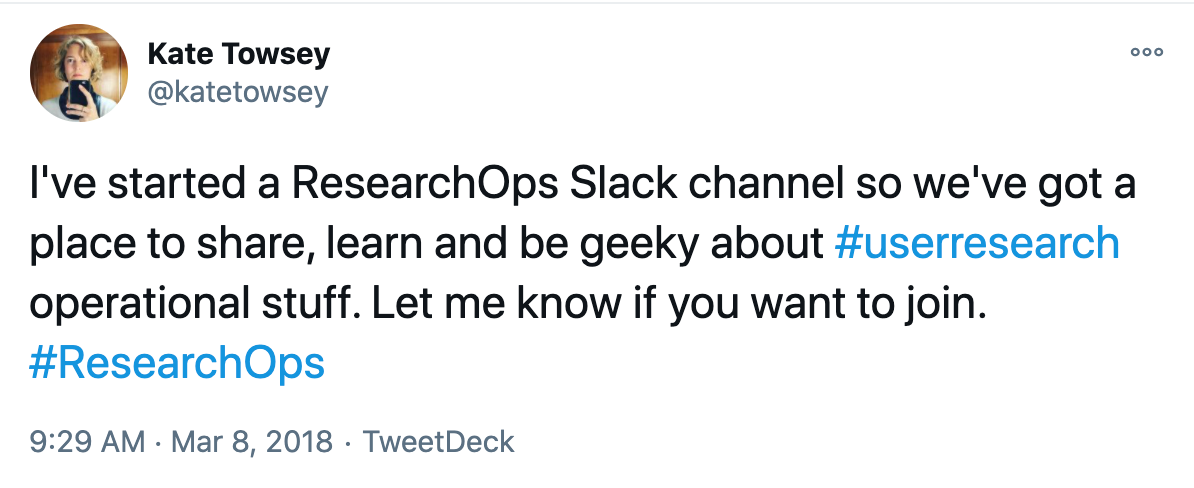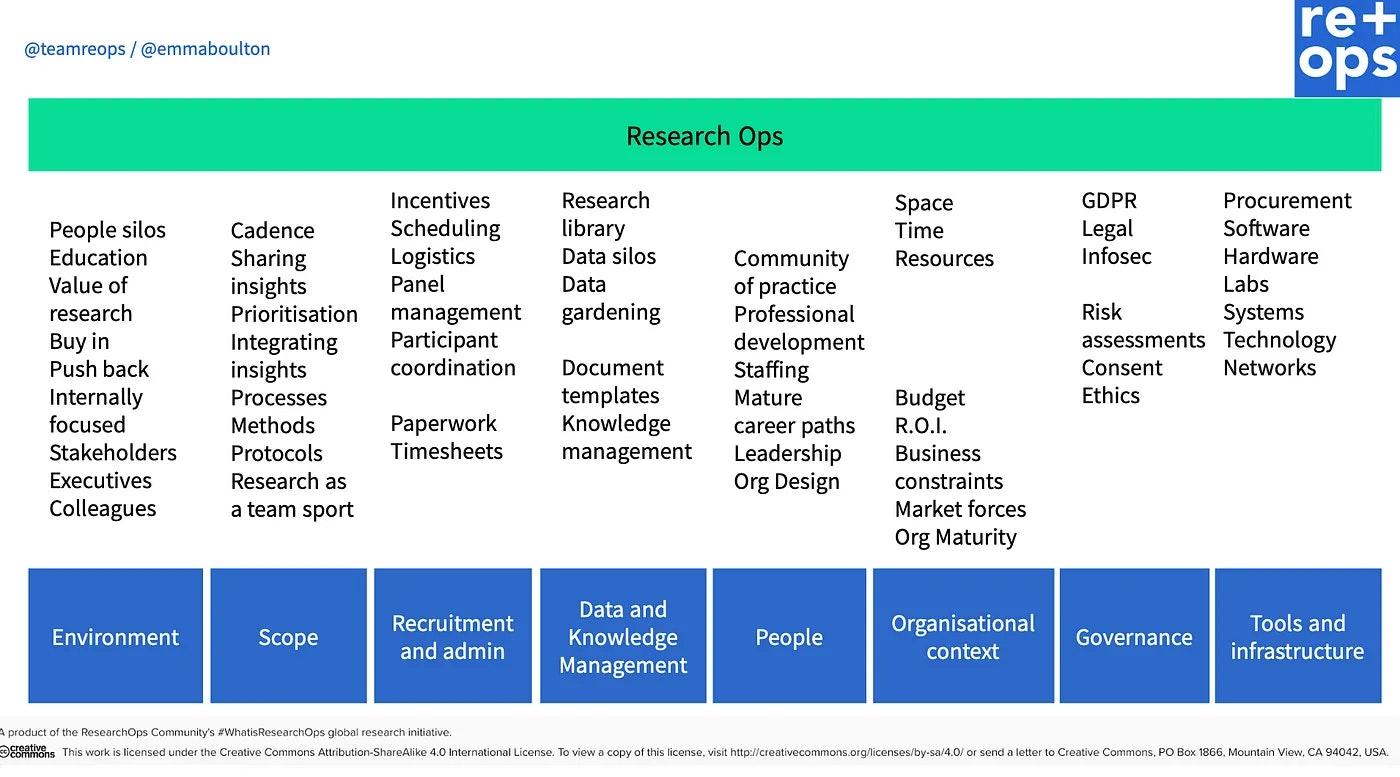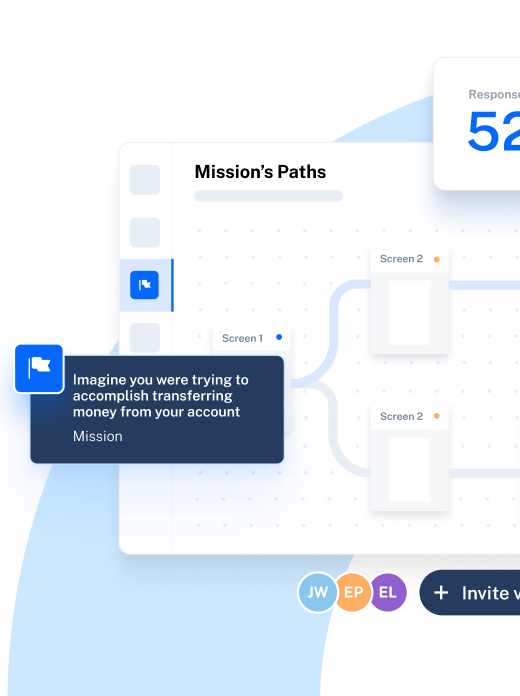A typical user research process has many moving parts—from recruiting the right participants and handling legal paperwork to conducting interviews, managing data, processing payments, and much more. It’s easy for things to get messy.
So how can product teams and researchers stay on track, boost efficiency, and avoid unnecessary delays in the user research process?
Two words: research operations.
In this article, we explore the concept of ResearchOps and its core pillars. We’ll also give you a step-by-step framework to create your own ReOps program in-house, and maximize the efficiency of your research efforts.
What is ResearchOps?
Research operations–aka, ResearchOps or ReOps–is the practice of creating, managing, and optimizing the workflows, people, and tools that support user research. It focuses on the ‘behind-the-scenes’ work that enables researchers to gather insights more efficiently and scale research efforts. This includes managing participant recruitment, organizing research data, and standardizing processes, allowing research teams to focus on the core work of understanding users.
The term first popped up in 2018 when Kate Towsey, Research Ops Expert, tweeted about her new ResearchOps community, created on Slack to discuss the operational aspects of UX research.
Since then, ResearchOps has become a strategic subset of DesignOps, helping research teams efficiently manage the behind-the-scenes operations of user and product research, and streamline all steps in the process.
User experience has fast become a key differentiator for SaaS companies. In fact, our 2025 Future of User Research Report showed that organizations that embed research into their business strategy and operations report 2.7x better outcomes—including 3.6x more active users and 2.8x increased revenue—highlighting the need for an established research operations program.
What does ResearchOps involve?
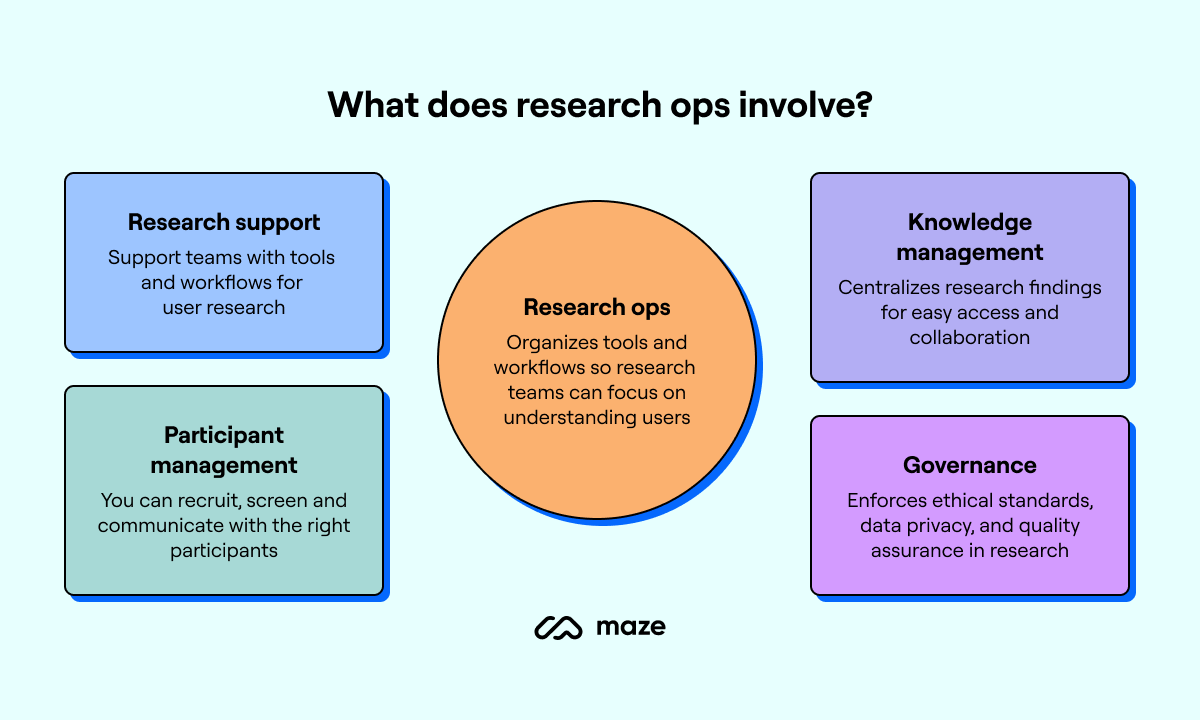
If you want to build your own ResearchOps program, start by understanding the key aspects involved in its function and setup.
Participant management
The success of your UX research efforts is closely tied to the quality of the research participants you recruit. Once you've defined the objectives and scope of your research, the next main step in ResearchOps is recruiting research participants.
Start by outlining what your ideal participants look like. This will give you more clarity on which specific user segments to target for your research.
Screening is another critical aspect of making your participant recruitment process airtight.
Whether you’re getting applications from interested participants or choosing candidates from a database, you have to properly screen all applicants to choose participants who meet the criteria for your study.
It is possible to save time and skip this step, using tools like the Maze Panel, which allows you to choose the perfect participants from a diverse pool of over 280 million testers. All these testers are pre-screened and you can set multiple filters to narrow your search and identify candidates that match your user personas.
Here’s the tricky part: despite your best efforts to recruit and screen candidates, managing participants and executing your workflows can quickly become overwhelming. This is where tools like Reach can help streamline this entire process, by letting you:
- Hire participants and build a database of testers
- Set up workflows to communicate with participants
- Get granular insights into every tester and select participants strategically
Tools like Reach make it easy to qualify participants in your database and run campaigns seamlessly. These solutions are time savers when it comes to participant management, so consider investing in one as part of your research operations toolstack.
Supporting researchers
Any user research program is only as good as its researchers, and it’s the ResearchOps team that helps empower the user researchers in your team. You can support your UX team members by building a good research tech stack.
Give them access to all essential UX research tools for implementing the end-to-end research process, including tools for remote testing, heat mapping, analytics, and more.
The ResearchOps team can also support researchers by setting up cross-functional workflows between different teams like customer success, product, marketing, and more. For example, ReOps can liaise with customer success and sales to understand what customers (and potential customers) are saying and help prioritize research initiatives. This guarantees your research insights are a two-way conversation, and are integrated well into product development and UX design discussions.
Knowledge management
Knowledge management setup is another essential part of ResearchOps. You need a centralized research repository to store all your findings and documentation. This knowledge hub will make it easier for teams to access past studies and research reports whenever needed, supporting teams from sales to product.
A centralized hub can go a long way in cultivating a user-centric culture and research democratization, erasing knowledge silos in favor of offering access to insights for everyone, from sales to support and product.
In the same vein, it’s a key step in evangelizing user research and helping to scale research, by exposing stakeholders and the wider organization to the work you’re doing.
You can also use this knowledge hub to share easy access to standard operating procedures (SOPs). These SOPs can standardize repeat workflows in your research projects, like onboarding participants or creating new surveys, to boost efficiency and ensure every research activity follows the same process.
Governance
UX research methods should meet certain ethical standards to respect participants’ privacy and protect their data. The ResearchOps team is in charge of ensuring research ethics standards are met during the research process.
One key element of this is sharing consent forms with all participants to get written permission to use their insights in your development efforts. These consent forms should also inform participants of how you'll use their data and the intention of your research.
Another governance responsibility is implementing measures for protecting sensitive information, in compliance with data protection laws. Supplement this with a rigorous quality assurance process to improve the quality of your research methods and make them more reliable.
How does Research Ops add value to your organization?
A good research operations setup can significantly improve the efficiency of conducting user research in many ways:
- Repeatable success: Set up your UX team for repeatable success by implementing consistent workflows
- Reduce admin: Boost productivity and free up researchers to concentrate on what they do best
- Align teams: Make user insights accessible and preventing research being conducted in silos
- Eliminate inconsistencies: Produce more reliable, high-quality results with a well-defined operational plan and the right tools
- Scale research: Build scalable processes that grow economically with your organization’s needs
- Secure buy-in: Help teams track research impact and get buy-in from key stakeholders
- Research ethics: Ensure data protection, best practices, and ethical standards to maintain user trust
Ultimately, a strong ResearchOps process enables you to build a more transparent and systematic approach to research, bringing everyone onto the same page, guaranteeing strategic alignment, and democratizing findings.
The 8 pillars of research operations
After Kate Towsey started the ResearchOps Community in 2018, the team launched a global project titled #WhatIsResearchOps. The goal was to drive informed conversations around the role of a UX researcher and its many operational demands. This project culminated in a framework defining eight key pillars of research operations.
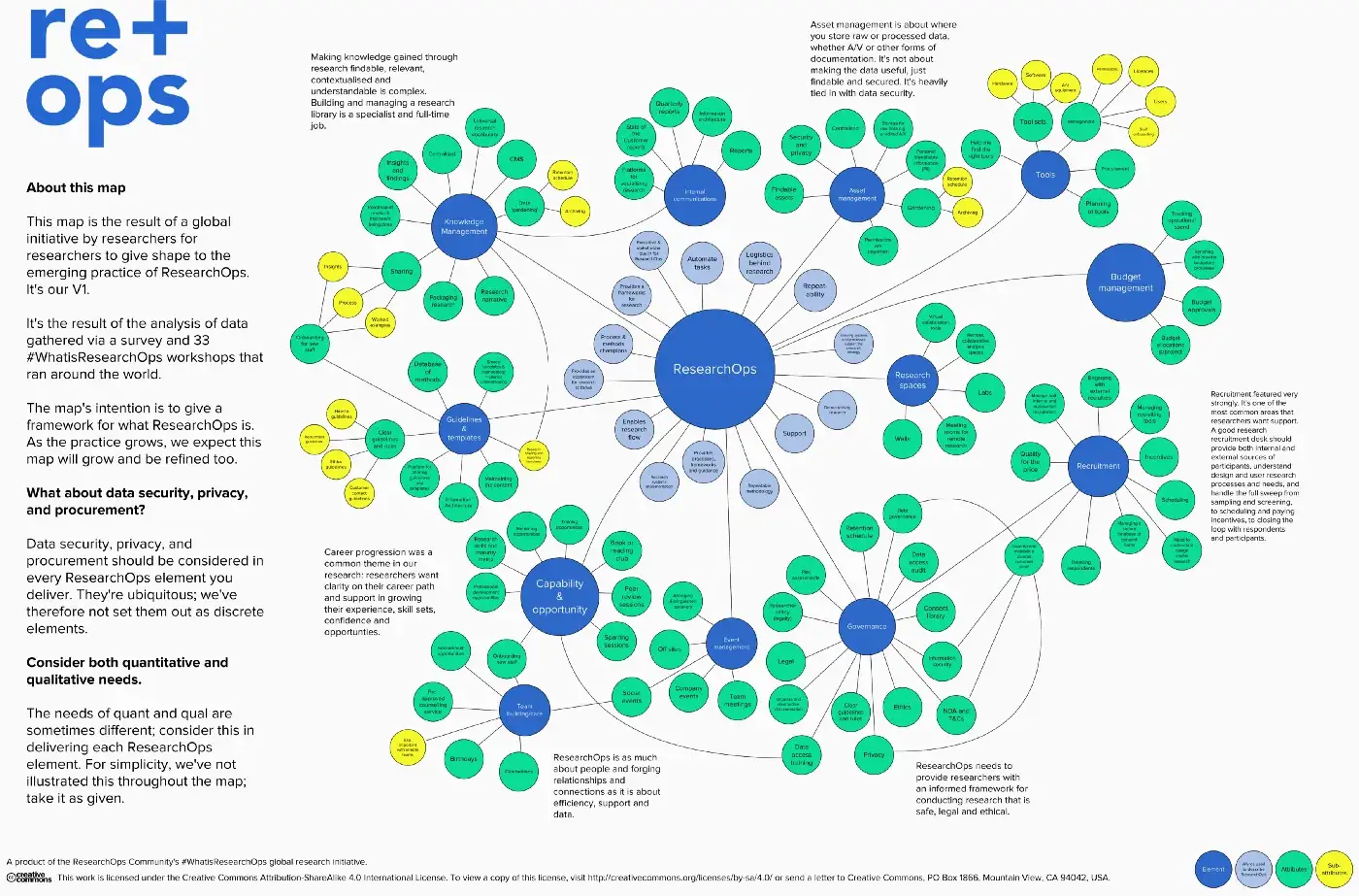
💡 You can download this framework via Mural, access it on Google Drive, or download it as a PDF.
These pillars provide a comprehensive structure for understanding the various components of ResearchOps. They offer a holistic perspective on the resources, support, and daily tasks that ensure research teams operate efficiently.
Let’s break down these eight pillars for establishing a strong research operations program.
1. Environment
The environment for your research studies can directly influence the outcomes. This environment refers to the context in which you’re conducting research, including details like participants’ location, behavioral traits, and motivations around your product.
This pillar focuses on choosing the right physical and contextual environment for your research methods. A suitable environment maximizes the validity of your results and enables you to collect insights that lead to a well-informed decision-making process.
2. Scope
The scope defines the breadth and depth of your UX research study. It lays down your project goals, methodologies, and expected outcomes.
This pillar requires chalking out the scope of your research projects to inform everyone of the steps and resources involved. It keeps UX research teams more focused on the project, in order to deliver relevant insights.
3. Recruitment and admin
Start by setting up the tools and workflows for the admin side of your research projects. Think participant recruitment, tester database, incentives, and similar tasks.
Besides recruiting candidates, this pillar also focuses on building relationships with these participants for long-term engagements.
This pillar essentially covers everything you need to find the right participants and seamlessly conduct your research. It’s all about making your research efficient and error-free from start to finish.
4. Data and knowledge management
From user interviews to usability testing, user research will bring you a large volume of research data. You have to set up a system to effectively collect, analyze, and store this data for current and future usage.
This pillar focuses on building a good knowledge management hub for all research documentation, reports, and learnings. This is crucial for giving easy access to all stakeholders. It also requires that you follow data privacy regulations, and ensures you don’t misuse information from research studies.
5. People
People are a critical part of any research operations function. You need a dedicated ResearchOps team to run the show and achieve targets. You also have to invest in researchers’ training and skill-building to consistently improve performance.
This pillar highlights the importance of constantly developing your UX team’s capabilities. It also requires you to establish strong collaboration between researchers and other stakeholders, like product managers, sales leaders, etc.
6. Organizational context
Good user research doesn’t operate in a vacuum. You need to align your research projects with broader organizational goals.
This pillar emphasizes the need to infuse more context about your company goals, team culture, and strategic priorities into your research methods. When you align research operational tasks with your company’s overall objectives, you can leverage research findings more holistically across your entire team.
7. Governance
All research activities should follow certain rules to maintain ethical integrity while pursuing your organizational priorities. The governance pillar reinforces globally-accepted rules and guidelines, like GDPR, that your research needs to align with.
This pillar is all about creating a strong governance framework and is crucial for making your research credible and reliable for future uses. You should also review this framework periodically to reflect changes in industry standards.
8. Tools and infrastructure
Your ResearchOps program needs a virtual laboratory to function effectively. You need a solid infrastructure to conduct research sessions, collect and process data, and derive useful insights.
This pillar covers all the research tools and resources you need to build a well-functioning ResearchOps lab. You have to design workflows to automate necessary aspects of your research methods and focus your team’s efforts on high-reward tasks.
Implementing research operations: a ReOps template
Ready to build your research operations function from the ground up? Here’s a tried-and-tested template to help you hit the ground running quickly.
Establish an effective ResearchOps framework
A ResearchOps program looks different in different organizations. This mostly depends on the growth stage and size of a company. Start by creating a research operations framework that aligns with your company’s overall objectives.
For example, if you’re an early-stage startup, your ReOps program should focus on understanding target users, identifying pain points, and validating product-market fit. Your UX research strategy would involve methods like rapid user testing and a clear prioritization of research objectives.
On the other hand, a growth-stage enterprise will focus more on scaling its research operations and investing more in optimizing the infrastructure.
Establishing your ResearchOps framework typically involves three steps:
- Assessing your current state of research and research maturity to identify gaps and opportunities
- Defining achievable goals and designing a ResearchOps team structure
- Mapping out a strategy based on current performance and expected results
You should aim to identify your research team’s challenges and pain points before setting up your operations strategy. This foundational step will set the tone for your future efforts to build a tailored ReOps program.
Build a team, then define roles and responsibilities
Once you’ve drawn out a strategy for your user research operations, the next step is to build a dedicated ResearchOps team within your UX team.
Revisit your strategy and assign different tasks/processes to specific roles, like research coordinator, ResearchOps manager, data analyst, etc. This will give you an idea of who’s already doing what, the type of positions you need to fill, and the number of people to hire for each role.
You can also define the skills and expertise required for each role to make the hiring process more effective. If you’re hiring for these roles internally, you can set up sessions to train employees for their responsibilities.
Engage the team and standardize workflows
Keeping your team engaged in different tasks is another critical step in the process. You can schedule regular syncs with all stakeholders from different teams—product, design, sales, and marketing—to collect their thoughts on research operations.
This will help in building better collaboration and setting up standardized workflows for all teams. You can convert these processes into SOPs for maximizing consistency in efforts and improving cross-functional performance.
Develop a ResearchOps knowledge hub
Documentation lies at the core of a good research operations setup. You need a knowledge management hub to store all relevant documents for your ResearchOps program. This will include:
- Detailed SOPs and guidelines for your research methods
- Quick-access links to relevant resources for your ReOps team
- Ready-to-use templates for reporting and other documentation
- Well-organized folders containing research findings and data from past studies
- A collection of FAQs answering questions and clarifying doubts about your processes
You can make this knowledge hub a centralized repository of crucial information for your research team. Moderate permissions to keep a few documents confidential and share edit access to let selected people update the content regularly.
This hub can also store your progress tracking reports. These reports will assess the effectiveness of your ResearchOps program against various metrics. You can share all reports with the team and compare your progress.
Incorporate ResearchOps into daily practices
Make ResearchOps a part of routine workflows to see the true impact of your strategy. You can schedule regular check-ins to discuss progress and get project updates. This would be a good place to discuss blockers and find areas of improvement.
You should also recognize and reward team members for their accomplishments. For example, if a new researcher completes their first user interview, celebrate their success with the team to build momentum.
Remember: don’t leave research operations on the back burner while you continue doing everything the old way. Make it a part of your daily processes and be persistent and consistent to make it a habit.
Optimize and monitor research operations
ResearchOps doesn’t work on a set-and-forget approach. You have to constantly review your framework and find scope for improvement.
That’s why it’s important to schedule periodic reviews with the entire team. The goal of these meetings should be to identify inefficiencies and bottlenecks holding you back.
While these meetings can happen on a monthly or quarterly timeline, you can use a feedback channel to collect team members’ inputs more frequently. This feedback can help you tackle day-to-day challenges and optimize performance.
Get started with essential ResearchOps tools
From organizing ideas to gathering user insights, each tool type supports different aspects of the research process.
User research insights tools for gathering and analyzing data
User research insights tools help you collect valuable data quickly from participants, making it easier to stay on track and make informed decisions. These tools help you run both moderated and unmoderated studies, enabling you to collect feedback and insights whether you're validating early concepts, conducting usability tests, or analyzing customer satisfaction.

Mind mapping and design tools for organizing research ideas
Mind mapping and design tools bring clarity to complex research tasks and make collaboration smoother. Tools like Miro, Figma, and Sketch allow you to visualize research goals, user journeys, and frameworks, breaking large amounts of data into smaller, manageable parts.
These tools keep your research structured and ensure no detail is overlooked. They also help track dependencies and keep your team aligned. As research evolves, you can quickly adjust and update your plans. These tools make research more efficient by simplifying data organization, speeding up decision-making, and improving team communication.
Project management tools for tracking progress and managing tasks
Project management tools—like Asana, Trello, Notion, and Airtable—offer a more linear layout, with categories represented as cards that you can organize by project stages or team responsibilities.
They help you track tasks, manage timelines, and ensure the research process stays organized. These tools allow you to break research into smaller, actionable tasks, assign responsibilities, and monitor progress at every stage. They let you build repeatable workflows, and help with planning, resource allocation, and keeping the team aligned on priorities.
Setting up ReOps for long-term success
Research operations is a transformative approach to level up your research workflows by systematically integrating people, technology, and processes.
It ensures every research endeavor is rooted in clarity, purpose, and strategic vision. With a solid ReOps program in place, you can create a thriving ecosystem for user research within your organization.
So, bookmark this guide and get ready to streamline your research infrastructure with an airtight ReOps program. What are you waiting for?
Frequently asked questions about ResearchOps
What does a research operations manager do?
What does a research operations manager do?
A research operations manager is responsible for building the infrastructure for user research. Their primary responsibility is finding tools, setting up workflows, and documenting SOPs to streamline research activities. They also oversee different aspects of research operations, like participant recruitment, compliance, logistics, etc.
What are the 8 pillars of research operations?
What are the 8 pillars of research operations?
The eight pillars of research operations are:
- Recruitment and admin
- Data and knowledge management
- Governance
- Tools and infrastructure
- Organizational context
- People
- Environment
- Scope
What does ReOps mean?
What does ReOps mean?
ReOps, also known as research operations or ResearchOps, refers to the people, tools, and processes required for conducting research. It's a discipline within DesignOps designed to help UX researchers tackle operational challenges and focus on their research projects.
What is the role of user research operations?
What is the role of user research operations?
User research operations focus on improving the backend operations of any research program. This involves managing user testing sessions, coordinating with participants, collecting and storing data, and making insightful reports.






